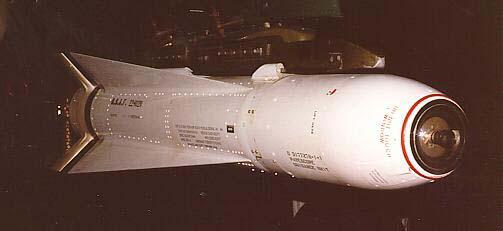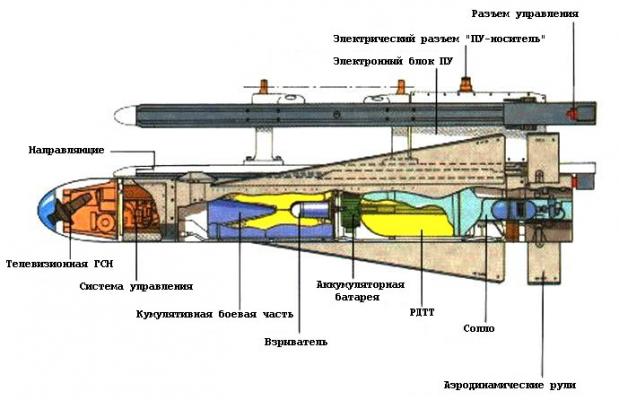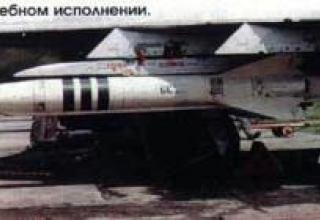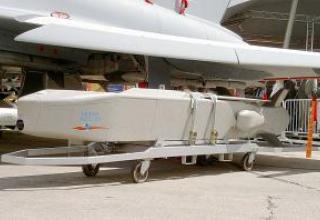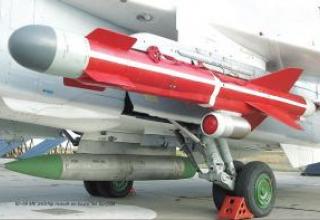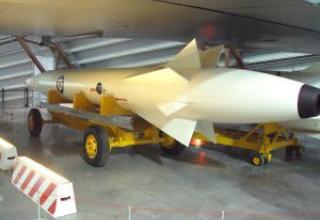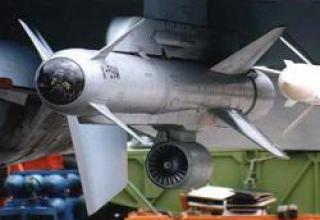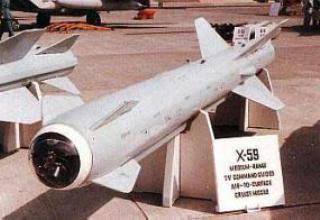"Maverick is an air-to-surface tactical missile designed to engage a wide range of targets: tanks, APCs, surface ships, launchers, fortifications. AGM-65A missiles with a television homing head were developed by the American company "Hughes Aircraft Co" and adopted for service in 1972. Since then, they have been successfully used in a number of local military conflicts and modernized up to the 90s. Totally six modifications with different versions of homing heads were developed.
Composition:
All variants of the "Maverick" rocket have the same normal aerodynamic plane scheme. A "M-65A and A "M-65B missiles differ from each other by the fact that the first one has a TV homing head with an angle of 5°, and the second one - 2.5°. Reducing the angle of view of the homing head allows you to detect the target and to capture it at a greater distance. Although the maximum launch range of Maverick missiles is 27 km, on average, depending on air transparency and lighting conditions, the practical range of confident engagement of a small target by a homing head ranges from 4 to b km when striking from low altitudes.
ASM-65A and ASM-65V missiles are equipped with 2-mode solid-fuel engines ТХ-481. In the launch mode it develops a thrust of 4540 kgf, and in the marching mode - 990 kgf. The total thrust pulse is 6160 kg, engine run time is 3.5s.
The missile's combat unit is a cumulative one with a contact fuse.
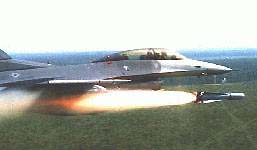
The pilot's actions when using these missiles are as follows. He usually flies to the target at low altitude. After visual detection and identification of the target, the pilot directs his plane in its direction. He then moves the weapon selection switch to the position corresponding to the selected missile, thus giving him commands to unwind the gyroscope and reset the homing head nose fairing cover. At the same time, the pilot achieves a range of heights up to 150-250 m. The image of the terrain from the homing head is transmitted to the sighting indicator in the cockpit. The pilot, watching the target visually, pilots the aircraft with the expectation that its image appears on the screen. When he finds the target on the screen, he puts an electronic crosshairs on it with the homing head handle and presses the "Tracking" button. This causes the Homing Head to enter target tracking mode. Having launched the rocket (from the permitted range), the pilot takes the plane out of the dive, into which he entered as a result of maneuvering at aiming (the maximum time of the last reaches 10-15 s), and depending on the task or situation leaves the battle or searches for a new target. For the ASM-65B missile application some changes were made in the sighting system, as a result of which the pilot's indicator instead of the electronic crosshairs displays 4 marks, with which he frames the selected target. In addition, there is an electronic cross on the screen, the position of which relative to the central marks shows the angle of deviation of the homing head axis (in the target tracking mode) from the aircraft longitudinal axis. If this angle is exceeded, the cross starts to change its brightness (flashing) periodically. In this case, the pilot must point the plane more accurately at the target. In addition, the upper left corner of the screen shows a sector that starts flashing if the homing head of the missile does not distinguish the target (great range, small size, insufficient optical contrast). A sector and a cross are illuminated with constant brightness when the conditions of target acquisition and tracking are met.
Characteristics:
| Airplane carrier | А-10, F-15E, F-16 |
| Missiles flight speed, km/h | 1150 |
| Range, km | 27 |
| The length of the rocket, mm | 2490 |
| The diameter of the rocket body, mm | 304.8 |
| Wingspan, mm | 711.2 |
| Start weight , kg | 207.90 |
| Weight of cumulative combat unit, kg | 56.25 |
| Engine weight TX-481, kg | 47.20 |
Testing:
Evaluating the results of the combat application of "Maverick" missiles with TV homing heads in Vietnam (A "Ì-65A), during the operation "Desert Storm", during flight tests and training launches (A "Ì-65A and A "Ì-65B) specialists note that these missiles have quite high accuracy. According to their calculations, the probability of a guided missile hitting a small target (tank, APC, etc.) was 85% on average. However, it is emphasized that such an indicator was achieved under favorable conditions (only during the day and with good visual visibility of the target), in which it is possible to use guided missiles with TV homing heads. This imposes great limitations on the use of missiles in Central and North European theaters of war, especially in winter, due to a significant reduction in daylight hours, frequent fogs and precipitation. Therefore, it is only possible to effectively use guided missiles with television homing heads during this period in 30% of daylight hours.
Sources:
- Широкорад А.Б. "История авиационного вооружения", -Мн.: Харвест, 1999.-560с.
